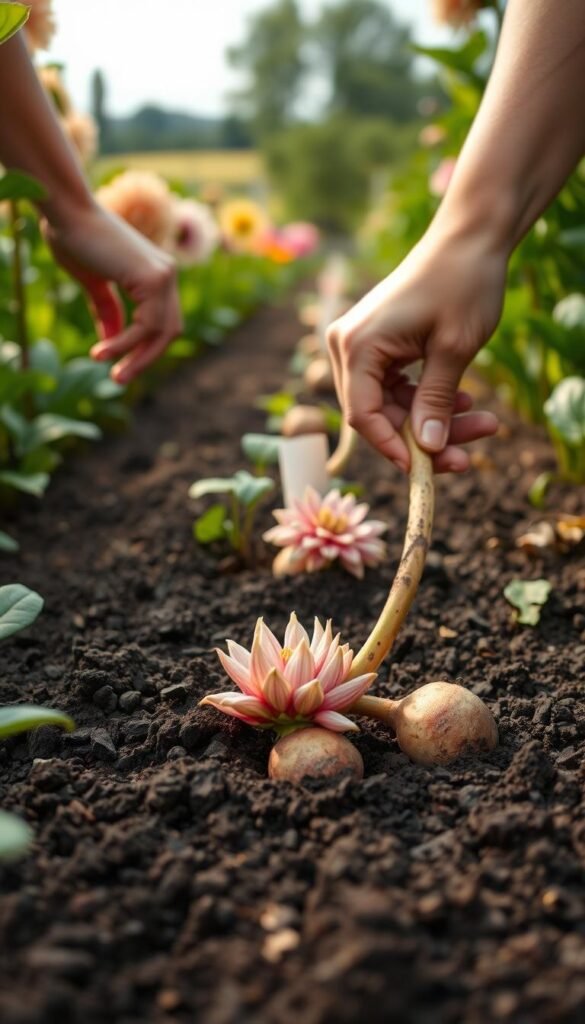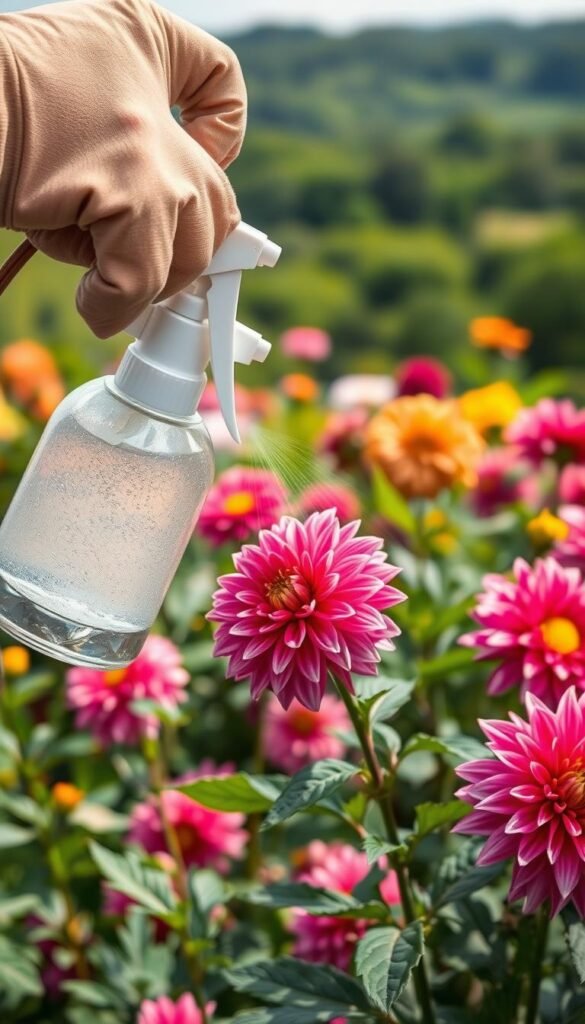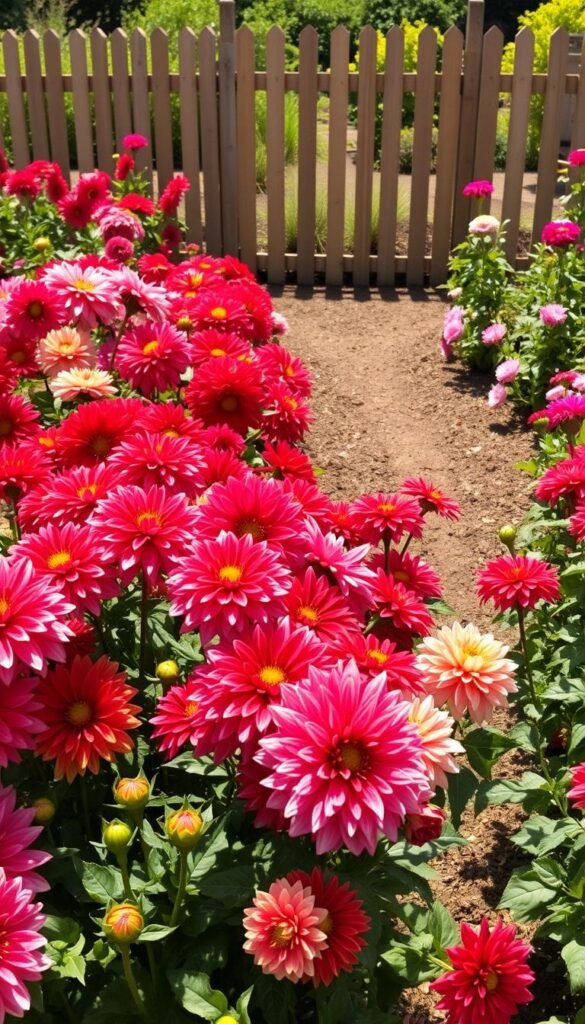Imagine your outdoor space bursting with vibrant colors from summer’s peak through autumn’s first chill. Dahlias deliver exactly that – stunning blooms in fiery reds, soft pinks, and even near-black hues. These tuberous plants offer endless possibilities, whether you want to brighten borders, create cut-flower arrangements, or add drama to containers.
Native to Mexico, these flowers have captivated gardeners for centuries. Today’s 60,000+ varieties range from petite 2-inch spheres to jaw-dropping 15-inch “dinner plate” blossoms. Their diverse forms – spiky cactus types, ruffled collarettes, and waterlily-inspired shapes – ensure there’s a perfect match for every style.
Success starts with smart preparation. You’ll need to consider your local climate, sunlight patterns, and soil quality. Choosing the right tubers makes all the difference between lackluster plants and showstopping displays that neighbors will envy.
This guide walks you through each decision, from selecting ideal varieties to timing your plantings perfectly. You’ll discover how to avoid common pitfalls while creating a space where these Mexican marvels truly thrive. Let’s unlock the secrets to growing dahlias that’ll make your green-thumbed friends ask, “How’d you do that?”
Understanding Dahlias and Their Growing Needs

Few plants offer such dazzling diversity as these sun-loving bloomers. Whether you’re drawn to fiery sunset tones or delicate pastels, there’s a type to match your creative vision – and your backyard’s conditions.
Dahlia Varieties and Color Options
From spiky ‘cactus’ types to ruffled ‘collarettes’, dahlia forms could fill an artist’s sketchbook. The Bishop of Llandaff variety stuns with scarlet petals against dark foliage, while Cafe Au Lait serves up creamy blush blooms the size of salad plates. Want pollinators? Single-flowered types with open centers attract bees like magnets.
Color choices span every hue except true blue. Mix vibrant orange ‘David Howard’ with purple ‘Thomas Edison’ for electric contrast, or create soft harmonies using pink ‘Jersey’s Beauty’ and white ‘Bride to Be’. Bicolors like ‘Checkers’ add playful patterns to borders and bouquets.
Sunlight, Soil, and Water Requirements
These plants crave morning sun – aim for 6-8 hours daily. “Dahlias will forgive many sins,” says veteran grower Marie D., “but never soggy roots.” Improve heavy clay by mixing in compost until the soil crumbles like chocolate cake. Well-draining earth prevents tuber rot while keeping nutrients accessible.
Water deeply 2-3 times weekly, letting soil dry slightly between sessions. Stake tall varieties early to avoid wind damage. With proper light and care, you’ll see first buds in 8 weeks – the start of a 3-month floral parade!
Planning a Dahlia Flower Garden: Step-by-Step Growing Guide

Your dahlia journey begins with two critical choices: quality tubers and smart spacing. Get these right, and you’ll create a floral masterpiece that evolves beautifully through the season.
Selecting Healthy Tuber Stock
Premium tubers feel like firm potatoes with visible pink eyes – those tiny buds signal life. Avoid shriveled or moldy specimens. “Eyes are non-negotiable,” advises Swan Island’s head grower. “No eyes mean no stems, no flowers.”
Reputable sellers like Floret and Summer Dreams Farm guarantee disease-free stock. Order early – popular varieties vanish by spring. Store tubers in peat moss until planting if they arrive before frost risks pass.
Designing Your Garden Layout and Spacing
Map your space using this simple guide:
| Dahlia Type | Height | Spacing | Best For |
|---|---|---|---|
| Dinnerplate | 4-5 ft | 3 ft | Back borders |
| Medium decoratives | 3 ft | 2 ft | Mid-bed displays |
| Bedding types | 1-2 ft | 12″ | Edging/containers |
Leave 18″ pathways between rows for easy access. Tall varieties go northward to prevent shading. Mix early and late bloomers for continuous color. Pair spiky forms with rounded blooms for textural drama.
Stake plants during planting to avoid root damage later. This foresight pays off when summer storms hit – your prized blooms will stand tall through the season’s challenges.
Planting and Early Care for Your Dahlia Garden

The magic happens when those tubers meet the earth – but timing is everything. Wait until soil temperatures hit 60°F and night frosts become a distant memory. In most regions, this sweet spot arrives between late April and May.
Step-by-Step Planting Instructions
Dig planting holes 6-8 inches deep – think shovel blade length. Mix 1 cup compost and ¼ cup bonemeal into each hole’s base. Position tubers horizontally with their eye buds facing skyward, like sunbathing astronauts. Cover with just 2-3 inches of soil initially.
| Task | Depth | Amendment | Timing |
|---|---|---|---|
| Initial planting | 6-8″ | Compost + bonemeal | Post-frost |
| Soil backfill | 2-3″ | None | At planting |
| Final depth | Full hole | Additional compost | As shoots grow |
Initial Watering and Soil Preparation Tips
Resist the watering can! Newly buried tubers need dry conditions to avoid rot. When green shoots punch through (about 2 weeks), begin weekly soakings. Gradually fill the planting hole as stems grow, creating stable support.
For eager growers, start tubers indoors 6 weeks early. Use 1-gallon pots with drainage holes and barely moist potting mix. Transplant outdoors after frost passed, hardening off plants first. This trick delivers blooms 3 weeks sooner!
Remember: well-draining soil prevents more problems than any spray bottle. Test drainage by filling your hole with water – it should disappear within 15 minutes. If not, add perlite or coarse sand to keep those roots breathing easy.
Maintenance Techniques: Staking, Fertilizing, and Pruning

Your vibrant display needs smart care to stay show-ready all season. Three key practices – structural support, nutrient management, and strategic trimming – transform good growth into spectacular results.
Building Strong Support Systems
Tall varieties become top-heavy by midsummer. Install 5-6′ bamboo stakes at planting time to avoid damaging tubers later. “Stems snap easier than celery,” warns Oregon grower Lila Torres. “Tie them loosely every 12″ using stretchy fabric strips.”
| Support Type | Height | Best For | Tie Material |
|---|---|---|---|
| Bamboo stake | 5-6 ft | Dinnerplate types | Old t-shirts |
| Tomato cage | 3 ft | Medium decoratives | Velcro strips |
| Pea netting | 4 ft | Multiple plants | Jute twine |
Fueling Growth Without Overfeeding
When stems reach 16″, pinch the central tip between thumb and forefinger. This triggers side shoots that double bloom counts. Use 5-10-10 fertilizer every 25 days – sprinkle ½ cup around each plant, then water deeply.
“High nitrogen makes leafy giants with few flowers. Stick to bloom-boosting formulas once stems start forming buds.”
Water Wisdom and Cleanup Routines
Check soil moisture with a finger – water when the top inch feels dry. Cut spent blooms at the stem base using sharp snips. This redirects energy to new buds rather than seed production.
Morning watering reduces fungal risks. Always avoid wetting foliage – direct your hose to the soil line. With these habits, your plants will pump out fresh flowers until frost nips the air.
Troubleshooting Dahlia Garden Challenges

Even the most vibrant displays can face unexpected hurdles. Let’s tackle common issues head-on so your blooms stay healthy from sprout to storage.
Identifying and Managing Pests and Diseases
Slugs love tender shoots like kids crave candy. Circle plants with copper tape – it delivers a harmless shock that deters these slimy thieves. For earwigs nesting in blooms, set traps using small pots filled with straw. Empty them daily into soapy water.
Powdery mildew appears as white dust on leaves during humid spells. Improve airflow by spacing plants properly and removing affected foliage. “Neem oil sprays work wonders if applied early,” advises Michigan grower Jenna K. For botrytis blight (gray mold), remove infected flowers immediately and avoid overhead watering.
Overwintering Tubers and Preventing Rot
After the first fall frost blackens foliage, it’s storage time. Dig carefully with a garden fork, keeping stems attached. Let tubers dry upside-down for 3 days in a frost-free shed. Brush off excess soil but don’t wash them – moisture invites rot.
| Storage Method | Material | Temperature |
|---|---|---|
| Vermiculite | Plastic bins | 40-45°F |
| Dry sand | Cardboard boxes | 50°F max |
| Peat moss | Paper bags | Cool basement |
Check stored tubers monthly. Discard any showing mushiness or strong odors. In zones 7+, heavy mulch layers (6-8″) may protect tubers left in ground. Container growers can move pots to garages, watering lightly every 45 days.
Envisioning Your Future Dahlia Garden Flourish
Picture this: your backyard transformed into a living canvas where bold hues dance from mid-summer through autumn’s curtain call. With proper care, those fist-sized tubers you planted will erupt into armloads of cut flowers, each stem boasting petals that rival stained glass in sunlight. Remember – success starts with choosing stock that has at least one visible eye, as highlighted in our dahlia care basics guide.
Come spring, enrich beds with fresh compost to fuel growth. Space plants according to their mature size – crowding stifles blooms. When summer heat arrives, consistent watering and biweekly feeding keep flowers coming. Snip stems frequently; cutting encourages more buds than leaving blooms to fade.
As frost looms, you’ll marvel at how those humble tubers became autumn’s grand finale. Store them properly, and next year’s display will be even brighter. Your journey from first planting to final harvest creates lasting skills – and bouquets that make every season feel like peak bloom.





